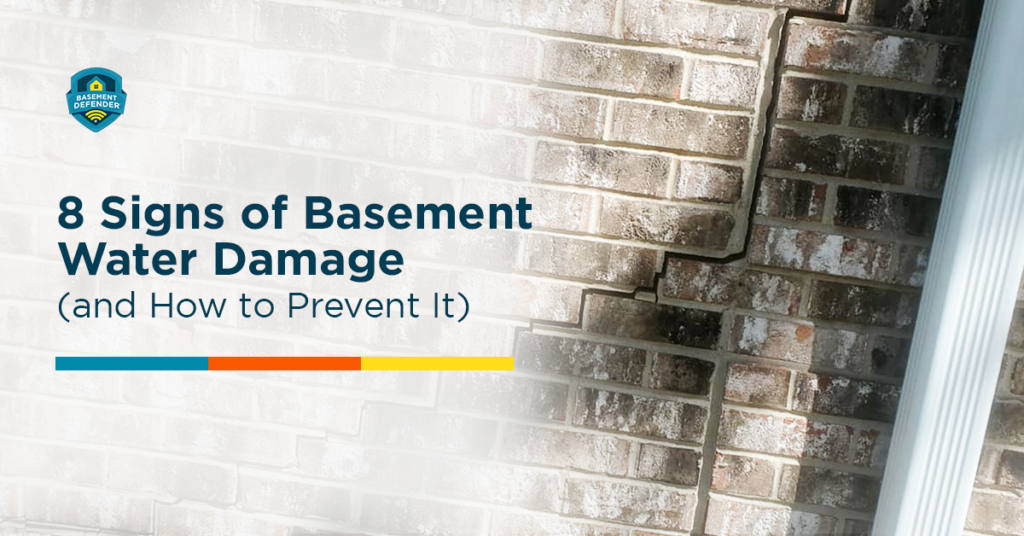
If your home has a basement, you may be familiar with water and drainage problems. According to iProperty Management, 98% of basements experience water damage from leaks at least once in their lifetime.
However, despite being a common occurrence, taking these matters seriously is essential. Basement water damage compromises your house’s structure, value, and safety, causing foundational cracks, electrical hazards, and health threats.
Understanding how to stop basement flooding before they worsen keeps your home secure through heavy rains and floods. So, let’s discuss the signs of water damage and how to prevent basement flooding to help you create a safer home.
While basement water damage has multiple causes, sump pump system failure is often the top reason. In fact, many of the following indications may result from sump pump basement flooding. With that in mind, here are the common signs of water damage and some tips to avert them effectively.
An obvious indication of basement water damage is discoloration, which indicates that moisture has saturated the area. Stains typically occur due to substantial water damage during extended sump pump flooding, pipe leaks, high-humidity condensation, or groundwater seepage.
You can resolve water stains by inspecting and repairing leaks. Install proper insulation and ventilation, then seal cracks and gaps to reduce moisture penetration. Also, consider painting your basement’s walls, floors, and ceilings with waterproof coatings to prevent water absorption.
Does your basement smell damp? These scents are a typical sign of water accumulation, lingering well after it has dried up. Musty odors have various sources, including microbial growth, rotting wood, sewer backups, and stagnant water, some of which are health hazards.
Regular sump pump maintenance is an effective way to eliminate odor-causing water buildup. Clean and dry wet areas thoroughly and remove rotten materials. You can also consider installing a dehumidifier or an exhaust fan to ventilate your basement and prevent foul scents.
Peeling paint typically stems from moisture infiltration and poor paint quality or application. Significant amounts of moisture in your basement may cause its interior paint to flake or form bubbles. It exposes the material underneath to further water damage and deterioration, worsening the problem.
Choosing the correct paint type for your basement by matching the material and finish with what the room needs is essential to protecting its walls and ceiling. Picking high-quality paint, priming surfaces adequately, and allowing enough drying time between coats also help mitigate flaking and bubbling.
Efflorescence is the formation of light stains on floors and walls due to minerals left behind when water evaporates. It indicates trapped moisture within walls and floors, even if they appear dry. While not necessarily harmful, the unseen water could cause irreparable damage to your walls, floors, and ceilings.
Solve your efflorescence problem by addressing its roots. Start by ventilating the room to dry it out thoroughly, then apply a waterproof coating on its interior and exterior walls. Finally, remove efflorescence with a stiff brush or a mild acid solution.
Wood is a porous and absorbent material. If your basement has wooden framing, floors, and furniture, they can absorb moisture and become bent, twisted, swollen, and cracked. Severe warping could impact the room’s stability, leading to costly repairs and replacements down the line.
Protect your basement furniture and fixtures by replacing them with high-quality wood. To further prevent excessive moisture, ensure proper treatment and sealing. It’ll avoid water penetration and maintain consistent temperature and humidity levels.
Metal corrosion is a significant problem since there’s little you can do to revert damaged items to their original state. Rust is dangerous to your basement’s pipes, wires, nails, screws, and appliances, so mitigating its formation is vital before it spreads.
The best way to fight rust is to protect exposed metal against oxygen and moisture with specialized coatings. If rust results from poor drainage, ensure proper sump pump discharge to reduce water accumulation in your basement.
Water from rainstorms, melted snow, broken pipes, and landscaping might collect around your house and exert hydrostatic pressure. It pushes stagnant-dense water against below-grade walls, causing moisture to infiltrate your basement via cracks, joints, and capillary action.
Wetness or erosion near your foundation walls and drip lines can be very damaging. These problems can be caused by clogged or too small gutters, downspouts and sump pump pipes leaking or misplaced, and poor grading around your foundation walls that allows water to pool.
Poor grading around the foundation walls may exacerbate these problems. You may need to fill in depressions that have formed near the downspout. You should also ensure that the land around your house slopes away from the foundation walls at a 5% grade for at least 10 feet. Doing so will drain water away from your home and protect your foundation.
Expansive soils, especially those containing smectite clay minerals, could expand up to 30% in volume. This rapid absorption and release of water can weaken your house’s foundation, leading to cracks along walls and floors. Additionally, it may cause your basement floor to sink, creating entry points for water infiltration.
Downspout or sump pump extensions (non-perforated corrugated plastic pipes) can be attached to the downspouts to direct flow further from the house. The pipes can either be laid on the ground surface or buried underground.
When you redirect stormwater, make sure it’s discharged to a suitable area. Downspout extensions can be used in combination with swales, rain gardens, or other structures that redirect or capture runoff, especially if a suitable area is not within a reasonable distance.
Water damage is a fact of life for many homeowners, but that doesn’t have to be the case. The key to protecting your basement from excessive moisture is to know the signs of damage to look out for. Refer to the list above to identify drainage problems in your home and take necessary action to mitigate their effects and avoid them moving forward and contact a local waterproofing expert.
To prevent moisture damage in your basement or crawl space, you need to act fast and stay alert. That’s why you should consider getting a sump pump monitoring system that can warn you of any water problems before they get worse.
Basement DefenderTM is a smart solution that lets you track your sump pump performance remotely through a Wi-Fi sump pump alarm. With Basement DefenderTM, you can keep an eye on your basement or crawl space from anywhere in the world. However, please note that Basement DefenderTM is not a mold remediator and does not guarantee mold prevention. If you suspect mold growth in your home, please consult a professional immediately.
Visit our shop or contact us to evaluate your basement sump pump system today!

Roy is a respected authority in the waterproofing industry, with over 40 years of experience under his belt. His company, Perma-Seal, has earned a reputation as Chicagoland’s premier waterproofing contractor, thanks to Roy’s unwavering commitment to quality, integrity, and customer satisfaction.
His latest innovation, the Basement Defender, is a testament to his dedication to providing homeowners with the best possible protection against basement flooding, representing a major leap forward in the industry’s efforts to prevent water damage and save homeowners from costly repairs.